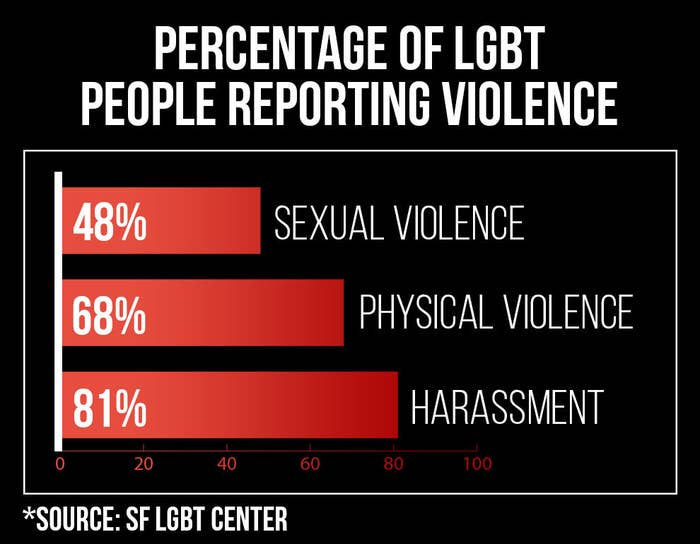
Despite San Francisco’s renown as a safe haven for LGBT people, more than two-thirds of LGBT people in the city have experienced physical violence, according to a report issued today.
For transgender people, who are amidst a national homicide epidemic, those rates are even higher: Nearly 4 out of 5 transgender people in San Francisco reported experiencing physical violence.
“When people say homophobia isn’t a problem here in San Francisco, it is very hard to refute that,” said Rebecca Rolfe, executive director of the SF LGBT Center, which conducted the first-of-its-kind survey with funding from the San Francisco Human Rights Commission. “We continue to come up against a lack of data and a mistaken belief that homophobia and transphobia are no longer a problem.”
“This data is important to help people understand this is a very significant problem,” Rolfe told BuzzFeed News. “And if this is a serious problem in San Francisco, it has got to be even more true in other parts of the United States.”
Researchers found that among LGBT people, 48% had experienced sexual violence, 68% experienced physical violence, and 81% reported harassment.
Sixty percent of transgender Latinas said they felt unsafe walking around during the daytime, compared with just 12% of other LGBT people.
Rolfe’s team found that transgender people not only reported higher rates of violence in every category — with 65% reporting sexual violence and 79% reporting physical violence — but also felt less safe in the city than other LGBT people. For example, 60% of transgender Latinas said they felt unsafe walking around during the daytime, compared with just 12% of other LGBT people.
The fear appears justified. Taja Gabrielle DeJesus, a Latina transgender woman, was fatally stabbed earlier this month in San Francisco, less than two weeks after another transgender woman of color was killed in a stabbing in Los Angeles.
But transgender people did not report feeling safest in the city’s traditionally gay neighborhood, the Castro, which attracts many white gay men. “Frequently people of color, women, and transgender people do not feel welcome there,” Rolfe said. “They can feel excluded based on race, gender, or gender presentation.” The area also has a “higher level of gay bashings that get reported,” she said.
"The Tenderloin is frequently seen as one of the least safe neighborhoods in city, but for many transgender people, that is where they feel safest because they have been able to build a community there," Rolfe said.
In addition to transgender people, violence for was most severe among LGBT people of color, along with those who are disabled, poor, homeless, or formerly incarcerated. "Violence patterns and disparities with the LGBTQI population suggests that the root causes underlying experiences with violence include racism, sexism, homophobia, transphobia, and other forms of discrimination," researchers found.
LGBT people reported feeling least safe walking alone at night, 46%, and riding transit, 33%.
The figures in the report, posted here, do not compare LGBT violence rates with the population at large.
In part, this is due to a need to break ground by focusing on an LGBT population, Rolfe explained. “In research, people often do not ask about gender identity or sexual orientation, so there is very little information about the circumstances about how LGBT people live their lives,” she said.
Police around the United States often do not track the sexual orientation or gender identity of victims, even in potential hate crimes, rendering law enforcement data spotty or meaningless. For example, an FBI hate crimes report in December found only 33 people in the United States were targeted in bias crimes for their gender identity, an implausibly low figure. The report found that one-fifth of all hate-crime victims in the country, or 1,461 people, were targeted for their sexual orientation.
Rather than relying on law enforcement data, the SF LGBT Center and its partners conducted surveys with more than 400 people who live, work, socialize, or receive services in San Francisco.
The report accounts for all types of violence, including between intimate partners, and found LGBT people are reluctant to tell authorities. “There are high levels of mistrust that police will help them if needed," researchers found. "Thrity-six percent overall don’t believe the police would help." The researchers found 44% of physically violent incidents went entirely unreported.
“Even though this is a local report, I think it has national implications,” Rolfe said. “We have never seen data like this on a national scale before.”
